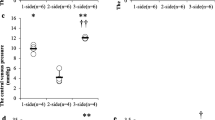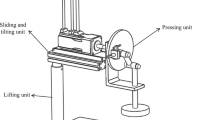Abstract
The provision of sufficient chest compression is among the most important factors influencing patient survival during cardiopulmonary resuscitation (CPR). One approach to optimize the quality of chest compressions is to use mechanical-resuscitation devices. The aim of this study was to compare a new device for chest compression (corpuls cpr) with an established device (LUCAS II). We used a mechanical thorax model consisting of a chest with variable stiffness and an integrated heart chamber which generated blood flow dependent on the compression depth and waveform. The method of blood-flow generation could be changed between direct cardiac-compression mode and thoracic-pump mode. Different chest-stiffness settings and compression modes were tested to generate various blood-flow profiles. Additionally, an endurance test at high stiffness was performed to measure overall performance and compression consistency. Both resuscitation machines were able to compress the model thorax with a frequency of 100/min and a depth of 5 cm, independent of the chosen chest stiffness. Both devices passed the endurance test without difficulty. The corpuls cpr device was able to generate about 10–40% more blood flow than the LUCAS II device, depending on the model settings. In most scenarios, the corpuls cpr device also generated a higher blood pressure than the LUCAS II. The peak compression forces during CPR were about 30% higher using the corpuls cpr device than with the LUCAS II. In this study, the corpuls cpr device had improved blood flow and pressure outcomes than the LUCAS II device. Further examination in an animal model is required to prove the findings of this preliminary study.




Similar content being viewed by others
References
Harrison-Paul R (2007) Resuscitation great. A history of mechanical devices for providing external chest compressions. Resuscitation 73(3):330–336. doi:10.1016/j.resuscitation.2007.01.002
Gassler H, Ventzke MM, Lampl L, Helm M (2012) Transport with ongoing resuscitation: a comparison between manual and mechanical compression. Emerg Med J. doi:10.1136/emermed-2012-201142
Gates S, Smith JL, Ong GJ, Brace SJ, Perkins GD (2012) Effectiveness of the LUCAS device for mechanical chest compression after cardiac arrest: systematic review of experimental, observational and animal studies. Heart 98(12):908–913. doi:10.1136/heartjnl-2011-301571
Halperin HR, Paradis N, Ornato JP, Zviman M, Lacorte J, Lardo A, Kern KB (2004) Cardiopulmonary resuscitation with a novel chest compression device in a porcine model of cardiac arrest: improved hemodynamics and mechanisms. J Am Coll Cardiol 44(11):2214–2220. doi:10.1016/j.jacc.2004.08.061
Steen S, Liao Q, Pierre L, Paskevicius A, Sjoberg T (2002) Evaluation of LUCAS, a new device for automatic mechanical compression and active decompression resuscitation. Resuscitation 55(3):285–299
Timerman S, Cardoso LF, Ramires JA, Halperin H (2004) Improved hemodynamic performance with a novel chest compression device during treatment of in-hospital cardiac arrest. Resuscitation 61(3):273–280. doi:10.1016/j.resuscitation.2004.01.025
Babbs CF (2006) Design of near-optimal waveforms for chest and abdominal compression and decompression in CPR using computer-simulated evolution. Resuscitation 68(2):277–293. doi:10.1016/j.resuscitation.2005.06.025
Betz AE, Menegazzi JJ, Logue ES, Callaway CW, Wang HE (2006) A randomized comparison of manual, mechanical and high-impulse chest compression in a porcine model of prolonged ventricular fibrillation. Resuscitation 69(3):495–501. doi:10.1016/j.resuscitation.2005.09.026
Jung E, Babbs CF, Lenhart S, Protopopescu VA (2006) Optimal strategy for cardiopulmonary resuscitation with continuous chest compression. Acad Emerg Med 13(7):715–721. doi:10.1197/j.aem.2006.03.550
Sunde K, Wik L, Naess PA, Ilebekk A, Nicolaysen G, Steen PA (1998) Effect of different compression–decompression cycles on haemodynamics during ACD-CPR in pigs. Resuscitation 36(2):123–131
Tomte O, Sjaastad I, Wik L, Kuzovlev A, Eriksen M, Norseng PA, Sunde K (2010) Discriminating the effect of accelerated compression from accelerated decompression during high-impulse CPR in a porcine model of cardiac arrest. Resuscitation 81(4):488–492. doi:10.1016/j.resuscitation.2009.12.028
Bankman IN, Gruben KG, Halperin HR, Popel AS, Guerci AD, Tsitlik JE (1990) Identification of dynamic mechanical parameters of the human chest during manual cardiopulmonary resuscitation. IEEE Trans Biomed Eng 37(2):211–217. doi:10.1109/10.46262
Neurauter A, Nysaether J, Kramer-Johansen J, Eilevstjonn J, Paal P, Myklebust H, Wenzel V, Lindner KH, Schmolz W, Pytte M, Steen PA, Strohmenger HU (2009) Comparison of mechanical characteristics of the human and porcine chest during cardiopulmonary resuscitation. Resuscitation 80(4):463–469. doi:10.1016/j.resuscitation.2008.12.014
Nysaether JB, Dorph E, Rafoss I, Steen PA (2008) Manikins with human-like chest properties–a new tool for chest compression research. IEEE Trans Biomed Eng 55(11):2643–2650. doi:10.1109/TBME.2008.2001289
Tomlinson AE, Nysaether J, Kramer-Johansen J, Steen PA, Dorph E (2007) Compression force-depth relationship during out-of-hospital cardiopulmonary resuscitation. Resuscitation 72(3):364–370. doi:10.1016/j.resuscitation.2006.07.017
Tsitlik JE, Weisfeldt ML, Chandra N, Effron MB, Halperin HR, Levin HR (1983) Elastic properties of the human chest during cardiopulmonary resuscitation. Crit Care Med 11(9):685–692
Higano ST, Oh JK, Ewy GA, Seward JB (1990) The mechanism of blood flow during closed chest cardiac massage in humans: transesophageal echocardiographic observations. Mayo Clin Proc 65 (11):1432–1440
Huemer G, Kolev N, Zimpfer M (1996) Transoesophageal echocardiographic assessment of mitral and aortic valve function during cardiopulmonary resuscitation. Eur J Anaesthesiol 13(6):622–626
Kouwenhoven WB, Jude JR, Knickerbocker GG (1960) Closed-chest cardiac massage. JAMA 173:1064–1067
Mair P, Kornberger E, Schwarz B, Baubin M, Hoermann C (1998) Forward blood flow during cardiopulmonary resuscitation in patients with severe accidental hypothermia. An echocardiographic study. Acta Anaesthesiol Scand 42(10):1139–1144
Criley JM, Niemann JT, Rosborough JP, Ung S, Suzuki J (1981) The heart is a conduit in CPR. Crit Care Med 9(5):373–374
Haas T, Voelckel WG, Wenzel V, Antretter H, Dessl A, Lindner KH (2003) Revisiting the cardiac versus thoracic pump mechanism during cardiopulmonary resuscitation. Resuscitation 58(1):113–116
Rich S, Wix HL, Shapiro EP (1981) Clinical assessment of heart chamber size and valve motion during cardiopulmonary resuscitation by two-dimensional echocardiography. Am Heart J 102(3 Pt 1):368–373
Rudikoff MT, Maughan WL, Effron M, Freund P, Weisfeldt ML (1980) Mechanisms of blood flow during cardiopulmonary resuscitation. Circulation 61(2):345–352
Dean JM, Koehler RC, Schleien CL, Atchison D, Gervais H, Berkowitz I, Traystman RJ (1991) Improved blood flow during prolonged cardiopulmonary resuscitation with 30% duty cycle in infant pigs. Circulation 84(2):896–904
Kramer-Johansen J, Myklebust H, Wik L, Fellows B, Svensson L, Sorebo H, Steen PA (2006) Quality of out-of-hospital cardiopulmonary resuscitation with real time automated feedback: a prospective interventional study. Resuscitation 71(3):283–292. doi:10.1016/j.resuscitation.2006.05.011
Mendoza Garcia A, Eichhorn S, Polski M, Knoll A (2014) Simulation of an electro-mechanical resuscitation device for cardiopulmonary resuscitation. Comput Cardiol Conf Proc 2014:1049–1052
Acknowledgements
The examination was also funded by Bayerische Forschungsstiftung, project “automation of an electrical driven resuscitation device, AZ1012-12”.
Author information
Authors and Affiliations
Corresponding author
Ethics declarations
Conflict of interest
Michael Heller is employed at GS Elektromedizinische Geräte G. Stemple GmbH.
Ethical approval
This article does not contain any studies with human participants or animals performed by any of the authors.
Rights and permissions
About this article
Cite this article
Eichhorn, S., Mendoza Garcia, A., Polski, M. et al. Corpuls cpr resuscitation device generates superior emulated flows and pressures than LUCAS II in a mechanical thorax model. Australas Phys Eng Sci Med 40, 441–447 (2017). https://doi.org/10.1007/s13246-017-0537-3
Received:
Accepted:
Published:
Issue Date:
DOI: https://doi.org/10.1007/s13246-017-0537-3




